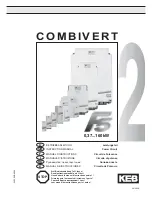
Page 21
©
2009 Magnum Energy Inc
.
2.3.6 Wiring the Inverter to the Battery Bank
CAUTION:
Inverter is NOT reverse polarity protected, if this happens the inverter will
be damaged and will not be covered under warranty.
Before connecting the DC wires
from the batteries to the inverter, verify the correct battery voltage and polarity using
a voltmeter. If the positive terminal of the battery is connected to the negative termi-
nal of the inverter and vice versa, severe damage will result. If necessary, color code
the cables (with colored tape): red for positive (+); black for negative (-) to avoid
polarity confusion.
Info:
The DC overcurrent device (i.e. circuit breaker) must be placed in the positive
(red) DC cable line between the inverter’s positive DC terminal and the battery’s posi-
tive terminal (red); as close to the battery as possible.
DC Ground Wire
Route an appropriately sized DC grounding wire (green or bare wire) from the inverter’s DC
equipment ground terminal (item 7 in
fi
gure 1-2) to a dedicated system ground. Recommended
tightening torque is 45 in lbf (5.1 Nm). Refer to section 2.6 for grounding information and sizing
the DC ground wires.
DC Negative Wire
Route an appropriately sized DC negative wire (black) from the negative terminal of the battery
bank to the inverter’s negative terminal (item 11 in
fi
gure 1-2).
Info:
If installing a battery monitor such as Magnum’s ME-BMK, install a DC shunt in-
line with the negative battery cable.
DC Positive Wire
Mount the circuit breaker assembly as near as practical to the batteries and open the circuit
breaker.
WARNING:
DO NOT close the DC circuit breaker to connect battery power to the
inverter at this time. This will occur in the
Functional Test
after the installation is
complete.
CAUTION:
If connecting live battery cables to the inverter DC terminals, a brief spark
or arc may occur; this is normal and due to the inverter’s internal capacitors being
charged.
Route and connect an appropriately sized DC positive wire (red) from the inverter’s positive DC
terminal (item 10 in
fi
gure 1-2) to one end of circuit breaker (or DC fuse block).
Connect a short wire (same rating as the DC wires) to the other side of the DC circuit breaker
and the other end of the short wire to the positive terminal of the battery bank (see
fi
gure 2-1
for reference). This is essential to ensure even charging and discharging across the entire battery
bank.
Ensure the DC wire connections (on the batteries, inverter and DC circuit breaker) are
fl
ush on
the surface of the DC terminal’s and the hardware (lock washer and nut) used to hold these con-
nections are stacked correctly (see
fi
gures 2-9 and 2-10). Verify all DC connections are torqued
from 10 to 12 ft lbf (13.6 to 16.3 Nm).
Once the DC connections are completely wired and tested, coat the terminals with an approved
anti-oxidizing spray.
Attach the red and black terminal covers over the inverter’s DC connectors and secure them in
place with the supplied screws.
If the batteries are in an enclosure, perform a
fi
nal check of the connections to the battery termi-
nals, then close and secure the battery enclosure.
Installation















































